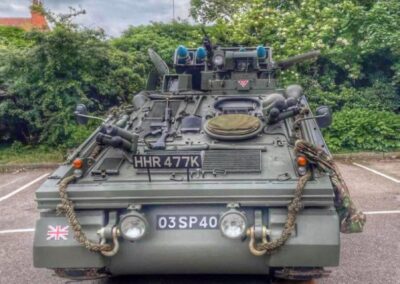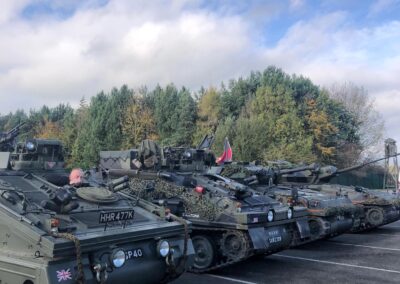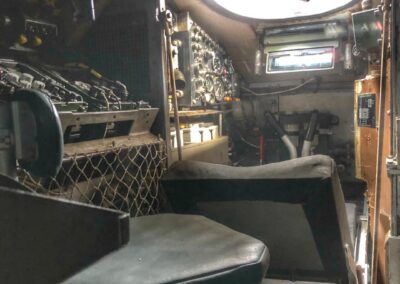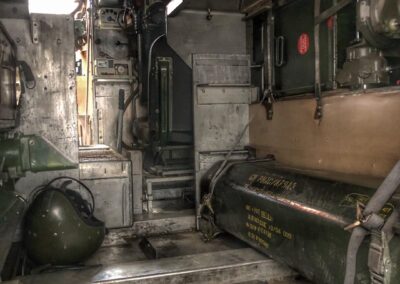FV102 STRIKER
Country: British
Entered Service: 1975
Crew: 3
Weight: 8.2 tons
Dimensions: Length – 4.83m
Armament: Main – 10x Swingfire Wire-Guided Missiles
Secondary – 7.62../0.3 machine-gun
Armour: Classified
Powerplant: Jaguar J60 No.1 Mk 100B 6-cylinder 142kW/190hp
Performance: Speed – Approx – 50mph.
It’s History…
Crew: 3
Main Armament: 5 swing fire ATGMs (5 reloads); Coaxial 7.62mm GPMG
Maximum speed: 50mph[1]
The FV102 Striker anti-tank missile carrier is a member of the British CVR (T) family of tracked armoured vehicles, produced by Alvis Vehicles. The FV102 is a version of another CVR(T). Its primary role is to defeat enemy armour. The first production vehicles were delivered in 1975. These anti-tank missile carriers are employed by anti-tank guided missile batteries and reconnaissance regiments.
The FV102 Striker is fitted with Swing fire anti-tank wire guided missiles. The name of the missile comes from the ability to make a rapid turn of up to 90° after firing. This missile has a HEAT warhead and an effective range of 4 km. It penetrates up to 800 mm of armour. The missile is controlled either by a direct optic or thermal sight. Missiles can be launched remotely from the vehicle. A special optical sight with a 100 m cable allows the crew to engage enemy targets from a safe cover. Missiles were originally controlled by a joystick controller. Later the FV102s were updated with semi-automatic control systems. Five Swing fire missiles are carried in the tilt-up launcher at the rear of the hull and are ready to use. A full set of reload missiles is stored inside the hull. Missiles are reloaded manually from outside the vehicle.[2]
The FV102 Striker anti-tank missile carrier is a member of the British CVR(T) family produced by Alvis whose role was to defeat enemy armour. The Striker was accepted in August 1974 and the British army ordered 96 and the Belgium Army 43. The first production vehicles entered service in 1976 where they were employed by anti-tank guided missile batteries of the Royal Artillery in BAOR and later by reconnaissance regiments of the Royal Armoured Corps.
This particular Striker was 1 of 4 manufactured as a Prototype/Trials Vehicle (designated P28) back in 1972 and was set aside for ‘Special Projects’ hence the SP number plate. It spent most of its life at the MVEE in Chertsey where it undertook extensive battlefield trials and guidance development. Initially, all CVR(T) vehicles were powered by the Jaguar J60 4.2-Litre 6-cylinder petrol engine which produced 265bhp, but were down rated to 195bhp for longer service life. This engine was chosen because it was commercially available and had high power-to-weight ratio. Later it was replaced under the LEP ‘Life Extension Programme’ with the Cummins BTA 5.9 Ltr diesel engine, which had a better fuel economy and similar performance. The vehicles were largely constructed from Armoured Aluminium to allow them to be Air Transportable by Hercules Aircraft and were fitted with collapsible floatation screens to enable them to be amphibious. This vehicle still has the screen fitted but these were removed from nearly all CVR(T)s back in the early 1980s.
The FV102 Striker was fitted with Swingfire anti-tank wire guided missiles that were produced by the British Aircraft Corporation. The name of the missile comes from the ability to make a rapid turn of up to 90 degrees after firing. The missile had a 7kg HEAT warhead and an effective range of 4km. It could penetrate up to 800mm of armour and was controlled by either direct optic or thermal sight. The missiles could be launched remotely from the outside of the vehicle, a special optical sight with a 100mm cable allowed the crew to engage enemy targets from a safe cover. Five Swingfire Missiles were carried in the tilt-up launcher at the rear of the hull and were ready to use and a further five were stored inside the hull.
Strikers saw battle service during Operation Desert Storm In 1991 and Enduring Freedom in 2003. In 2005 the Swingfire as officially replaced with the Javelin Anti-tank missiles to meet the new requirements and it is now the main anti-tank missile used by the British Army, which in turn has rendered the Striker as obsolete and is no longer in service.
[1] https://www.tanks-encyclopedia.com/coldwar/UK/FV-102-striker.php
[2] http://www.military-today.com/missiles/fv102_striker.htm





